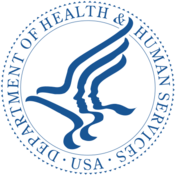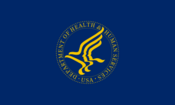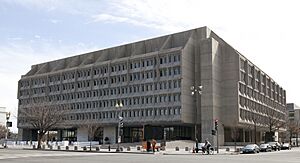United States Department of Health and Human Services facts for kids

Seal of the US Department of Health and Human Services
|
|

Flag of the US Department of Health and Human Services
|
|
 Hubert H. Humphrey Building, Department headquarters |
|
| Department overview | |
|---|---|
| Formed | April 11, 1953 (as the Department of Health, Education, and Welfare) |
| Preceding agencies |
|
| Jurisdiction | Federal government of the United States |
| Headquarters | Hubert H. Humphrey Building Washington, D.C. |
| Employees | 62,000 |
| Annual budget | $1.631 trillion (2022) |
| Department executives |
|
The United States Department of Health and Human Services (HHS) is a very important part of the U.S. government. Its main job is to protect the health of people in the United States and provide helpful services. Think of it as a big team working to keep everyone healthy and safe. Its motto is "Improving the health, safety, and well-being of America."
Before 1979, this department was called the Department of Health, Education, and Welfare (HEW). That's because it also included the Department of Education, which later became its own separate department.
The person in charge of HHS is called the Secretary of Health and Human Services. The President chooses this person, and the United States Senate has to agree.
The U.S. Public Health Service Commissioned Corps is a special group of uniformed health professionals within HHS. It's led by the Surgeon General, who helps with public health issues.
Contents
History of HHS
How it Started: Federal Security Agency
The story of HHS began on July 1, 1939, with something called the Federal Security Agency (FSA). This agency was created to bring together all the government programs related to health, education, and social security. It was a way to organize these important services under one roof.
The FSA included several key parts:
- The Public Health Service (PHS), which focused on health.
- The Office of Education, which dealt with schools and learning.
- The Social Security Board, which helped with financial support for people.
Becoming a Cabinet Department
On April 11, 1953, the Federal Security Agency changed and became the Department of Health, Education, and Welfare (HEW). This was a big step because it became a "Cabinet-level" department. This means its leader, the Secretary, is part of the President's main group of advisors.
The first Secretary of HEW was Oveta Culp Hobby. She was a very important person who had led the Women's Army Corps during World War II.
The new HEW department included many important groups:
- The Public Health Service
- The Office of Education
- The Food and Drug Administration (FDA), which checks food and medicines.
- The Social Security Administration
Renamed to Health and Human Services
On October 17, 1979, the Department of Health, Education, and Welfare was renamed the Department of Health and Human Services (HHS). This happened because the education parts of the department moved to a brand new department, the United States Department of Education.
Later, in 1995, the Social Security Administration also became its own separate agency. This left HHS focused mainly on health and human services.
How HHS is Organized
Leadership and Structure
The United States Secretary of Health and Human Services leads the Department of Health and Human Services. The President of the United States chooses this person, and the United States Senate must approve them.
The Secretary gets help from the United States Deputy Secretary of Health and Human Services. There are also seven assistant secretaries who help manage different parts of the department.
Many agencies within HHS are part of the U.S. Public Health Service (PHS).
Immediate Office of the Secretary
The Immediate Office of the Secretary (IOS) is the top group that works directly with the Secretary. They help manage HHS and include:
- The Office of the Deputy Secretary (DS) – This office handles all the daily operations of the department.
- The Office of the Chief of Staff (COS) – This office helps coordinate all the staff and support.
- The Office of the General Counsel (OGC) – This office provides legal advice.
- The Office of National Security (ONS) – This office looks after security programs within HHS.
Office of the Secretary
The Office of the Secretary (OS) is another important group that reports to the Secretary. It includes offices led by assistant secretaries, such as:
- The Office of the Assistant Secretary of Health and Human Services for Financial Resources (ASFR), which manages money.
- The Office of the National Coordinator for Health Information Technology (ONC), which deals with health technology.
- The Office of the Assistant Secretary of Health and Human Services for Public Affairs (ASPA), which handles communication with the public.
Working with Others: Regional Offices
The Office of Intergovernmental and External Affairs (IEA) helps HHS work with state, local, and tribal governments. They also work with non-government groups. Through this office, HHS makes sure its health programs reach people across the country.
HHS has Regional Offices across the United States. These offices work with state governments to put HHS policies into action in different areas. Each office has a director chosen by the President.
| Region | Regional Director | Subordinated States |
|---|---|---|
| Region 1 | Paul Jacobsen | Connecticut, Maine, Massachusetts, New Hampshire, Rhode Island, and Vermont |
| Region 2 | Dennis González | New Jersey, New York, Puerto Rico, and the Virgin Islands |
| Region 3 | Dalton Paxtan | Delaware, District of Columbia, Maryland, Pennsylvania, Virginia, and West Virginia |
| Region 4 | Thomas Bowman | Alabama, Florida, Georgia, Kentucky, Mississippi, North Carolina, South Carolina, and Tennessee |
| Region 5 | Joshua Devine | Illinois, Indiana, Michigan, Minnesota, Ohio, and Wisconsin |
| Region 6 | Julia Lothrop | Arkansas, Louisiana, New Mexico, Oklahoma, and Texas |
| Region 7 | Scott Conner | Iowa, Kansas, Missouri, and Nebraska |
| Region 8 | Elsa Ramirez | Colorado, Montana, North Dakota, South Dakota, Utah, and Wyoming |
| Region 9 | Bonnie Preston | Arizona, California, Hawaii, Nevada, American Samoa, Commonwealth of the Northern Mariana Islands, Federated States of Micronesia, Guam, Marshall Islands, and Republic of Palau |
| Region 10 | Renée Bouvion | Alaska, Idaho, Oregon, and Washington |
U.S. Public Health Service Agencies
The Public Health Service (PHS) is a big part of HHS. It includes many agencies that work on public health. The Public Health Service Commissioned Corps (PHSCC) is also part of the PHS.
Some of the important agencies under the Public Health Service are:
- National Institutes of Health (NIH) – This group does a lot of research to find cures and treatments for diseases.
- Centers for Disease Control and Prevention (CDC) – The CDC works to protect people from health threats and diseases.
- Indian Health Service (IHS) – This service provides health care to Native American and Alaska Native people.
- Food and Drug Administration (FDA) – The FDA makes sure our food, medicines, and medical devices are safe.
- Agency for Toxic Substances and Disease Registry (ATSDR) – This agency helps protect people from harmful substances.
Human Services Agencies
Besides the Public Health Service, HHS also has other important agencies that focus on human services:
- Administration for Children and Families (ACF) – This agency helps children and families.
- Administration for Community Living (ACL) – This group supports older adults and people with disabilities.
- Centers for Medicare & Medicaid Services (CMS) – CMS runs programs like Medicare and Medicaid, which help people pay for health care.
Office of Inspector General
The Office of Inspector General, US Department of Health and Human Services (OIG) is like the police force for HHS. Their job is to investigate any criminal activity related to HHS programs. For example, they look into fraud involving Medicare and Medicaid. The agents who work for OIG are trained to investigate financial crimes.
Former Agencies
- Social Security Administration – This agency used to be part of HHS but became an independent agency in 1995. It helps provide financial support to retired people, those with disabilities, and survivors.
See also
 In Spanish: Departamento de Salud y Servicios Humanos de los Estados Unidos para niños
In Spanish: Departamento de Salud y Servicios Humanos de los Estados Unidos para niños
- Early Head Start
- Head Start
- Healthy People 2010
- History of public health in the United States
- Rural health



